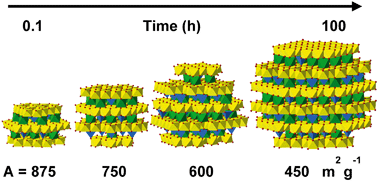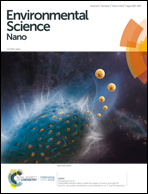Evolution of the reactive surface area of ferrihydrite: time, pH, and temperature dependency of growth by Ostwald ripening†
Abstract
Surface area is a crucial property of metal oxides for scaling ion adsorption phenomena. For ferrihydrite (Fh), the value is uncertain. Moreover, it rapidly changes with time, pH, and temperature. In this study, the dynamic change of the reactive surface area has been probed with phosphate for ferrihydrite, produced by ultra-fast neutralization at 20 °C. The initial nanoparticles are very small (d ∼ 1.68 nm), have a remarkably large specific surface area (A ∼ 1100 m2 g−1), and contain on average only 45 Fe atoms. Our data reveal the rapid change of the surface area showing that the rate of growth decreases by nearly three orders of magnitude (R ∼ 0.01–10 μmol Fe m−2 h−1) within one week of ageing. The rate of growth is proportional to the square of the super saturation of the solution (Qso/Kso)2, which suggests a rate limitation by dual attachment of Fe to a surface site of growth. This process is significantly hindered by the presence of weakly bound organic molecules, particularly at low pH, implying for soils that natural organic matter may considerably contribute to the kinetic stability of the natural iron oxide fraction. Our data also show that the reaction pathways are very different in NaNO3 and NaCl solutions. The decrease of surface area in NaNO3, prepared in traditional batch experiments, can be described excellently with the above rate law implemented in our dynamic model. This model also covers the temperature dependency (4–120 °C) of Fh ageing using an activation energy of Ea = 68 ± 4 kJ mol−1. For traditionally prepared 2LFh, our model suggests that with solely dual Fe attachment, the growth of the primary particles is limited to d ∼ 3–4 nm (A ∼ 350–500 m2 g−1). Larger particles can be formed by oriented attachment of particles, particularly at a high temperature. Using forced hydrolysis at 75 °C, large particles (d ∼ 5.5 nm) can also be produced directly. According to our model, Ostwald ripening of such 6LFh particles will be limited due to their low solubility.

- This article is part of the themed collection: Interfaces Against Pollution


 Please wait while we load your content...
Please wait while we load your content...